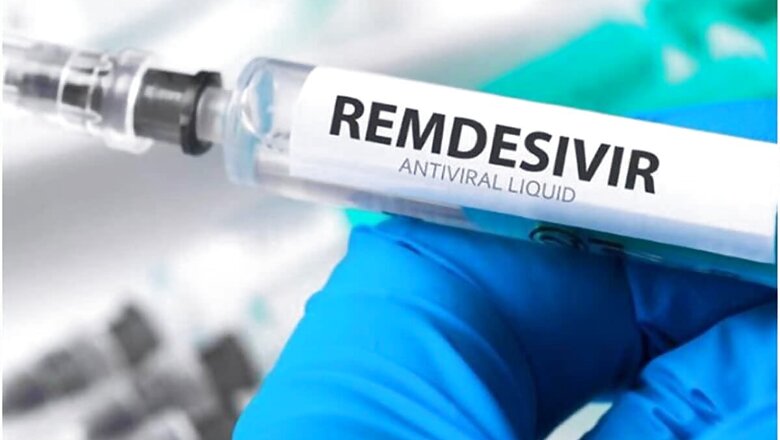
views
Soon after the start of the second wave of COVID-19 pandemic in India, the images of people standing in long queues outside the chemist stores/pharmacies across India, were all over the newspapers. These queues were to purchase prescription-only medicine Remdesivir, that was being prescribed for COVID-19 patients. This antiviral drug was developed in 2014 to treat ebola virus disease and was subsequently explored as a treatment against the hepatitis C virus and Middle East Respiratory Syndrome (MERS). The drug aims to reduce viral replication by preventing the copying of the virus in human cells.
A small-scale trial, published in April 2020, indicated that Remdesivir inhibits the replication of SARS-CoV-2 and prevents further spread. However, the clinical efficacy of the drug in reducing the duration of illness and preventing death was unknown. In the absence of any proven medication, these early research findings were considered promising, which resulted in Emergency Use Authorization (EUA) of this drug in many countries, including India. The clinicians started to prescribe Remdesivir as ‘off level use’ for COVID-19 management. Alongside, to understand efficacy, a number of large trials—the Solidarity trial conducted by WHO, the DisCoVeRy trial by Institut National de la Santé Et de la Recherche Médicale, France, another trial in the US, and two more in China had had been conducted, which had Remdesivir as one of the drugs under study.
The drug was prescribed extensively for treatment of COVID-19 patients in India and other countries, for much of 2020. A number of Indian manufacturers received the licence to produce a generic version of Remdesivir, from Gilead, the company which had the patent for the drug. By last quarter of 2020, Indian manufacturers had a reported production capacity of around 3.5 million vials a month. It was relatively expensive but available in sufficient supply. In October 2020, the situation changed when the findings of WHO-led multi-country Solidarity trial were released, which did not note any effect on the progression to ventilation or mortality in COVID-19 patients. Since then, WHO does not recommend the use Remdesivir for COVID-19 management.
Clinicians in India were divided about its benefit in COVID-19 management. Many gave preference to their opinion and experience, and continued to prescribe Remdesivir for COVID-19 treatment. By December 2020, the number of COVID-19 cases came down and supply of Remdesivir far exceeded the demand. The manufactures stopped the production, which reportedly went down to nil by early 2021.
Yet, in the second wave in India, when cases started rising, the demand for Remdesivir increased. However, though Indian manufacturers had the capacity to produce Remdesivir; the production and distribution cycle would take 20–25 days. This supply-demand gap resulted in long queues of anxious family members of patients hoping to buy the drug. Before the shortage of medical oxygen in India started getting attention, it was the queues for Remdesivir injections at the chemist stores that was in the limelight. The shortage meant the availability of the drug in the black market at a price many folds higher than the MRP.
The COVID-19 pandemic has brought the underlying challenges of the Indian healthcare system to the forefront. Though there are schemes in Indian states to provide free medicines and diagnostic services to patients, yet a chain of chemist stores outside every big or small hospital and healthcare facility in India is proof that medicines and diagnostics services are not available in the government facilities. The National Health Accounts of India, the official government publications, year after year have noted that out of the total expenditure on medicines and diagnostics in the country, which stands at around Rs 170,000 crore annually, less than 10 per cent comes from the government and nearly 90 per cent comes from the pockets of the people. The cost of drugs and medicines constitutes a large share in out-of-pocket expenditure (OOPE) in both hospitalisation and out-patient-based health services in India. The medicines and diagnostics, in any set up or situation, should be available and accessible as per the need of the people. However, shortage of Remdesivir is only the tip of the iceberg of the challenge to provide access to medicines in India. Furthermore, the black-marketing of Remdesivir, an essential drug, (and later on that of medical oxygen) demands for a stricter enforcement of health regulations and curbs on such practices.
There is another dimension. Though clinical trials have not found Remdesivir beneficial in COVID-19 treatment; however, clinicians in India and even the national COVID-19 task force and expert groups in India continue to recommend the use of Remdesivir in the treatment protocol, though in a few specific situations only. However, there are media and ground reports that Remdesivir is being prescribed extensively by many doctors for COVID-19 management beyond the recommended groups. This reflects another challenge of how medical fraternity use scientific finding viz-à-viz personal experience and underscores the challenge of insufficient adherence to standard treatment guidelines.
India is in the middle of a severe second wave of the COVID-19 pandemic and issues related to supply of Remdesivir are likely to be resolved in the coming weeks. However, we need to increase use of scientific evidence in clinical case management and guidelines development, which would require more and sustained work. The government funding and investment for assured provision of medicines, supplemented by improved forecasting, procurement and supply chain management need to be strengthened. Once the ongoing pandemic wave is over, there would be a need to analyse these aspects to learn and implement corrective actions. The pandemic is one more reminder to strengthen the healthcare system in India.
This piece was first published on ORF.
Read all the Latest News, Breaking News and Coronavirus News here. Follow us on Facebook, Twitter and Telegram.
















Comments
0 comment